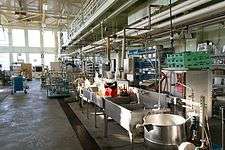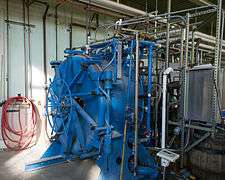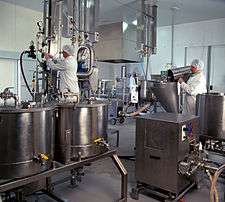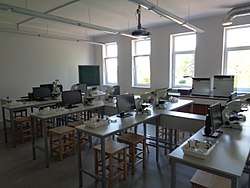Food science
Food science is the applied science devoted to the study of food. The Institute of Food Technologists defines food science as "the discipline in which the engineering, biological, and physical sciences are used to study the nature of foods, the causes of deterioration, the principles underlying food processing, and the improvement of foods for the consuming public".[1] The textbook Food Science defines food science in simpler terms as "the application of basic sciences and engineering to study the physical, chemical, and biochemical nature of foods and the principles of food processing".[2]
Activities of food scientists include the development of new food products, design of processes to produce these foods, choice of packaging materials, shelf-life studies, sensory evaluation of products using survey panels or potential consumers, as well as microbiological and chemical testing.[3] Food scientists may study more fundamental phenomena that are directly linked to the production of food products and its properties.
Food science brings together multiple scientific disciplines. It incorporates concepts from fields such as microbiology, chemical engineering, and biochemistry.
Disciplines
Some of the subdisciplines of food science are described below.
Food chemistry
Food chemistry is the study of chemical processes and interactions of all biological and non-biological components of foods.[4][5] The biological substances include such items as meat, poultry, lettuce, beer, and milk as examples. It is similar to biochemistry in its main components such as carbohydrates, lipids, and protein, but it also includes areas such as water, vitamins, minerals, enzymes, food additives, flavors, and colors. This discipline also encompasses how products change under certain food processing techniques and ways either to enhance or to prevent them from happening.
Food physical chemistry
Food physical chemistry is the study of both physical and chemical interactions in foods in terms of physical and chemical principles applied to food systems, as well as the application of physicochemical techniques and instrumentation for the study and analysis of foods.
Food engineering

Food engineering is the industrial processes used to manufacture food.
Food microbiology
Food microbiology is the study of the microorganisms that inhabit, create, or contaminate food, including the study of microorganisms causing food spoilage.[6] "Good" bacteria, however, such as probiotics, are becoming increasingly important in food science.[7][8][9] In addition, microorganisms are essential for the production of foods such as cheese, yogurt, bread, beer, wine and, other fermented foods.
Food packaging
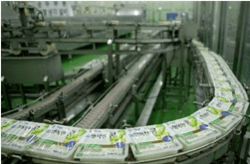
Food preservation
Food preservation involves the causes and prevention of quality spoilage
Food substitution
Food substitution refers to the replacement of fat, sugar, or calories from a product while maintaining similar shape, texture, color, or taste.
Food technology
Food technology is the technological aspects. Early scientific research into food technology concentrated on food preservation. Nicolas Appert’s development in 1810 of the canning process was a decisive event. The process wasn’t called canning then and Appert did not really know the principle on which his process worked, but canning has had a major impact on food preservation techniques.
Molecular gastronomy
Molecular gastronomy is the scientific investigation of processes in cooking, social and artistic gastronomical phenomena. Molecular gastronomy is a subdiscipline of food science that seeks to investigate the physical and chemical transformations of ingredients that occur in cooking. Its program includes three axis, as cooking was recognized to have three components, which are social, artistic and technical.
New product development
New product development includes the invention of new food products.
Quality control

Quality control involves the causes, prevention and communication dealing with food-borne illness.
Quality control also ensures that product meets specs to ensure the customer receives what they expect from the packaging to the physical properties of the product itself.
Sensory analysis
Sensory analysis is the study of how consumers' senses perceive food.
By country
Australia
The Commonwealth Scientific and Industrial Research Organisation (CSIRO) is the federal government agency for scientific research in Australia. CSIRO maintains more than 50 sites across Australia and biological control research stations in France and Mexico. It has nearly 6,500 employees.
South Korea
The Korean Society of Food Science and Technology, or KoSFoST, claims to be the first society in South Korea for food science.[10]
United States
In the United States, food science is typically studied at land-grant universities. Many of the country's pioneering food scientists were women who had attended chemistry programs at land-grant universities (which were state-run and largely under state mandates to allow for sex-blind admission), but then graduated and had difficulty finding jobs due to widespread sexism in the chemistry industry in the late 19th and early 20th centuries. Finding conventional career paths blocked, they found alternative employment as instructors in home economics departments and used that as a base to launch the foundation of many modern food science programs.
The main US organization regarding food science and food technology is the Institute of Food Technologists (IFT), headquartered in Chicago, Illinois, which is the US member organisation of the International Union of Food Science and Technology (IUFoST).
See also
Publications
Books
Popular books on some aspects of food science or kitchen science have been written by Harold McGee and Howard Hillman, among others.
Journals
Notes and references
- ↑ Heldman, Dennis R. "IFT and the Food Science Profession." Food Technology. October 2006. p. 11.
- ↑ Potter, Norman N.; Hotchkiss, Joseph H. (1998). Food Science. Food science texts series (5th ed.). Springer. ISBN 9780834212657.
- ↑ "Food Science Activity Guides". IFT.org. Retrieved February 2, 2015.
- ↑ John M. de Man.1999. Principles of Food Chemistry (Food Science Text Series), Springer Science, Third Edition
- ↑ John M. de Man. 2009. Food process engineering and technology, Academic Press, Elsevier: London and New York, 1st edn.
- ↑ Fratamico PM and Bayles DO (editor). (2005). Foodborne Pathogens: Microbiology and Molecular Biology. Caister Academic Press. ISBN 978-1-904455-00-4.
- ↑ Tannock GW (editor). (2005). Probiotics and Prebiotics: Scientific Aspects. Caister Academic Press. ISBN 978-1-904455-01-1.
- ↑ Ljungh A, Wadstrom T (editors) (2009). Lactobacillus Molecular Biology: From Genomics to Probiotics. Caister Academic Press. ISBN 978-1-904455-41-7.
- ↑ Mayo, B; van Sinderen, D (editor) (2010). Bifidobacteria: Genomics and Molecular Aspects. Caister Academic Press. ISBN 978-1-904455-68-4.
- ↑ "Korean Society of Food Science and Technology (KoSFoST)". KoSFoST. Retrieved 11 December 2016.
Further reading
- Wanucha, Genevieve (February 24, 2009). "Two Happy Clams: The Friendship that Forged Food Science". MIT Technology Review.
External links

- Food science at Curlie (based on DMOZ)
- Learn about Food Science
